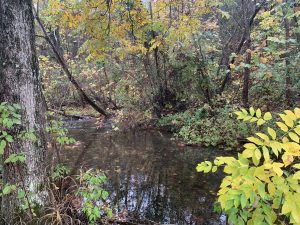
My sit spot.
I began my observations at my sit spot at 12:18 PM, which falls under the general time of day that is categorized as “day time”. I have actually done all of my sit spot observations during this time of day because it provides copious amounts of natural light that I can use to clearly make my observations pertaining to sight. Moreover, I have repeatedly picked this time of day because I find that I feel a bit safer in the light of day where I can see my surroundings completely.
When I traveled to my sit spot, it was raining lightly; this rain entailed a grey sky that was enveloped in clouds. This is actually the first time that I have done my sit spot under these weather conditions and even though I was not excited to get soaked from the rain, I was eager to see what new experiences the precipitation would bring. As I sat there recording my observations, I felt the occasional cold water droplet hit my face; this is the price, I suppose, of waiting to do your sit spot‒you run the risk of having to sit in the rain. I wanted to note that there is something about the rain that produces a distinctive smell that can only be characterized as “earthy”; I recently learned that in this phenomenon, called petrichor, plants release different oils into the air when it rains, and this produces the characteristic smell. Furthermore, it was very cold when I went to do my sit spot, and I approximated it to be around 50 degrees Fahrenheit; this may be somewhat of a warmer temperature for some individuals, but as a resident of Arizona I was extremely cold even with the excessive amounts of layers that I had worn.
My sit spot had changed considerably since I had last visited. Most notably, the leaves of the trees in the forest had begun to reflect the fall season and were varying shades of green, yellow, orange, and red; furthermore, the ground, which was still heavily populated by wild grasses, was now covered in leaf litter of the same vibrant shades. Moreover, all of the flowering plants around my sit spot had died; this included various ironweed plants as well as an unidentified species of yellow flower. These flowering plants were characterized by their decaying brown leaves and shriveled, dried up petals. While I was at my sit spot I had the opportunity to observe a few animals that I had not seen previously when making my observations. Primarily, the first insect I observed was a yellow moth, only visible to me after I had accidentally kicked a bush when readjusting the position in which I was sitting. The yellow moth instantly vacated the disturbed shrubbery, flew past me, and settled on a nearby leafy plant. When I went to inspect the moth, I realized why it had evaded my senses; it stood almost completely still on a yellow leaf that was the exact same shade as the bug. The yellow coloring that the insect bore on its wings and body was similar to that of an unripe lemon; although the color was distinctively yellow, it seemed to be mixed with light shades of green. The moth was also tiny, and it couldn’t have been bigger than the size of a quarter. The moth was quick to leave the site in which I had situated myself, flying away again only minutes later to a location out of sight. The species of this moth is unknown to me, but after I did some initial research I suspect that it may be a Hahncappsia moth, which has the distinctive yellow coloring I observed, a smaller wingspan (averaging 18 mm), and is commonly found in Virginia. I have not seen this organism previously, but I suspect this is because I am not completely in touch with my senses; this organism’s capability to blend in with the environment most likely enabled it to live undetected by me. The next organism I observed was a slug that had attached itself to the bark of a nearby black walnut tree; this slug was also somewhat camouflaged in its surroundings, as the brown color of its body was a nearly identical shade of the brown bark which it sat upon. At first, the slug was curled up around its own body, and over a lot of time, it descended the tree trunk and crawled to the forest floor. I have not seen this unknown species of slug in my sit spot before, and I think I was able to witness it this time because of the rainy weather conditions. Slugs and snails are known to dislike sunny weather because it has the potential to dry out their bodies; therefore, this slug was probably out in the forest because the weather provided a moist environment in which it could thrive. The final animal I observed was a tiny black spider that had actually fallen on my sit spot journal from the tree above. This black spider was truly minuscule, and its body was actually smaller than a dime. I watched this spider as it paced the page of my notebook and then when it crawled on my leg. I noted that this insect was extremely sensitive to touch, as when I attempted to guide it down my leg with my pencil it began to run in circles. Again this species was unknown to me, and I believe that I have not seen it previously because of chance. There are numerous organisms present in the environment where my sit spot is located, and I do not have the chance to observe every single one.
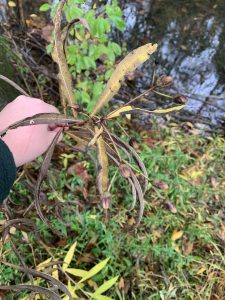
The Ironweed plant is almost completely dead. Its petals have withered and its leaves have turned a brown color.
Many things had changed in my sit spot since the last time I had visited; in fact, each of the three things I have been following during the duration of this study had been altered in some way. The ironweed flowers that I was able to identify in a previous journal entry were almost completely dead. The petals of every single plant had shriveled and each protruded from a dead, black bud. The soft, diamond-shaped leaves of the ironweed plant that were once a vibrant green were now crunchy and a brownish-black color; the stems that we
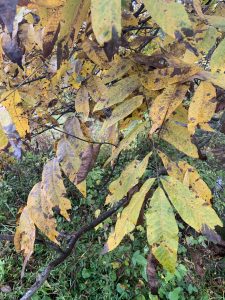
The leaves of the black walnut tree have changed to more autumnal colors.
re previously a greenish-brown had also experienced a coloration change to a murky yellow. The black walnut tree, which has been a steady constant in the weeks prior, had also shown signs of change; its vibrant forest green leaves were now autumnal shades of yellow and orange, but some of the green that was originally present on the leaves was still in view. Many of the leaves of the black walnut tree had been shedded and floated on top of the stream below. This stream (which has also been fairly consistent during the duration of this study) also appeared to have been altered, most likely because of the rain.
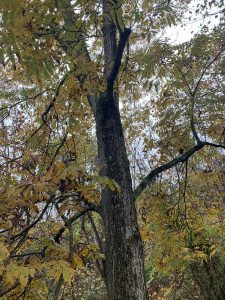
The black walnut tree has shedded some of its leaves.
The water of the stream was murky and turbid, and this contrasted with the clear waters that I had previously observed; however, I was still able to see some of the fresh leaf litter that lined the bottom of the stream. The water level was also higher than what I had previously witnessed, and this
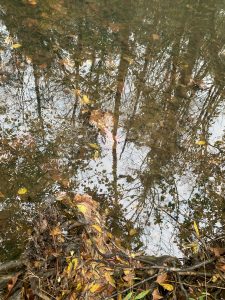
Leaf litter can be seen in the turbid waters of the stream.
can be attributed to the rain which served as an incoming source of water.

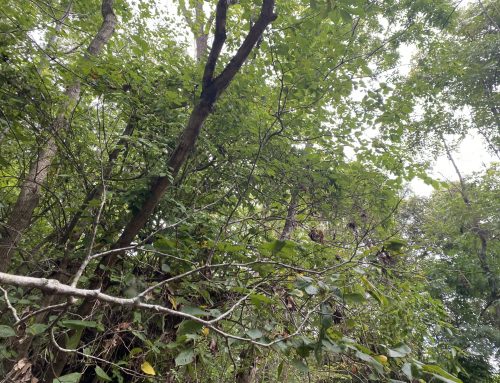
Hello, I love your blog post! I was laughing to myself at the stark differences in our way of describing the weather! Just as you had commented on my blog about my view on perspective, behold, another one! I am from Maine so the weather was to me, balmy. How funny! Anywho, the delicate and detailed way in which you described each of the species you came upon was quite lovely and the imagery great. I cans see you put a lot into this as you also did research on what species the individuals could be. It was also quite fun to read your post as you painted a picture in my mind. Great Job!!
Hi Olivia! Your sit-spot looks like a lot of fun to be in, very peaceful. I also really like how you’re so descriptive with the elements around you, it almost makes it feel like the reader is sitting there with you. Making friends with that spider must have been an enjoyable time for you! Nice job!